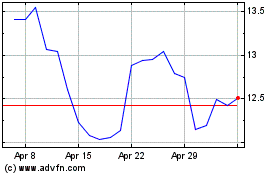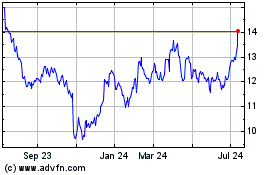By Christina Rogers
Senior executives at Ford Motor Co. have come to expect emails
from their new boss, Chief Executive Jim Hackett, that includes
links to TED Talks and articles from Science Daily. They often come
around 11 p.m., when he catches up on his reading.
The former chief of an office-furniture maker, Mr. Hackett
frequently references the work of theoretical physicist Geoffrey
West and uses terms such as "think phase" (a concept from his
design background) and "clock speed" (a phrase from computing). In
conversations, he often reaches for the nearest piece of paper or
whiteboard to articulate his thinking by sketching out a
diagram.
In a company long ruled by a rigid operational structure, Mr.
Hackett's cerebral, free-flowing management style has won some fans
and mystified others. For investors, the question remains: What
exactly is he thinking?
Ford's finance chief, Bob Shanks, said some of Mr. Hackett's
concepts make his head hurt. "But I'm eager to understand. I'm
eager to learn." Mr. Shanks, who joined Ford in 1977, said the
business hasn't been performing at the level it should. "If someone
thinks they have a better mousetrap, I'm all in."
A number of top Ford executives have left within the past year,
and many longtime employees and managers have struggled to adjust
to his approach, say current and former workers. Some executives
have turned to Mr. Hackett's 28-year-old chief of staff for
translations.
Mr. Hackett took over in May 2017, just when the Dearborn,
Mich., car maker was in need of a turnaround. The company that
invented the moving assembly line is grappling with new threats,
from self-driving cars to electric vehicles to ride-hailing. Car
makers are competing not just with each other but also with Silicon
Valley upstarts.
Ford's profits and stock price are down as Ford has fallen
behind rivals that have moved more quickly into new technologies
and quit money-losing businesses.
Mr. Hackett's goal is to better position the company to tackle
these challenges in part by engineering a culture shift, pushing
executives to be less regimented and more open-minded. He has
introduced new methodologies from his previous job, including a
process called "design thinking" that attempts to solve problems by
getting into the mind of the consumer.
While the auto maker's net income rose to $7.6 billion last year
due to pension and tax changes, its operating profits -- once among
the healthiest in the industry -- are on track to fall for a third
straight year in 2018. General Motors Co. continues to widen its
profit lead and smaller rival Fiat Chrysler Automobiles NV has said
it would outearn Ford this year in Ford's core North American
market.
Many insiders, analysts and investors remain unclear about
Ford's direction, saying Mr. Hackett has been too vague. Ford's
stock price -- which rose to over $17 a share in 2014 -- hit a
five-year low last month, after the company reported a
weaker-than-expected quarter and lowered its full-year guidance.
Ford's stock price closed at $9.46 Friday, down 15% since Mr.
Hackett took over in May 2017.
"The consistent message I get from investors is they see Ford
trying to do things, but it is taking too long and there aren't
enough specifics," said Evercore Partners auto analyst George
Galliers.
Losses are growing in the company's international operations,
including in Europe and China, and profits are under pressure in
Ford's core North American market. Ford's net income in the second
quarter fell 48% as higher commodity costs also dented the bottom
line.
Recent executive departures include Ford's top lobbyist, Ziad
Ojakli, who left for SoftBank Group Corp. in July after 14 years at
Ford. John Casesa, Ford's former head of strategy, quit last fall
after Mr. Hackett's debut investor presentation left Wall Street
wanting more detail on the company's plans.
Mr. Hackett said some of the departures were retirements, and
that he had asked Mr. Casesa to stay. He said Ford still has a
strong team and "deep bench."
He has urged patience, telling analysts on a recent earnings
call the company is making "tremendous progress" and that he will
share more information about his plans once decisions are made. He
said Ford, which is undertaking a thorough redesign of the
business, will be a better-structured company over time.
"Corporations tend to reward action over thinking," Mr. Hackett
said in an interview. "But the truth is...you'll find the companies
that didn't do the deep thinking and acted quickly have to redo
things."
The core of Mr. Hackett's plan is to make "smart vehicles for a
smart world" and remake Ford into a technology-savvy provider of
connected cars and transportation solutions.
Earlier this year, Mr. Hackett took the stage at the Consumer
Electronics Show in Las Vegas to unveil a new service called the
Transportation Mobility Cloud. The service provides software that
connects cars to each other and the broader transportation network,
with the aim of helping people move around more efficiently.
Under Mr. Hackett's direction, Ford has killed off several
unprofitable sedan and small-car models and reallocated spending to
higher-profit pickup trucks and sport-utility vehicles. He aims to
slash $25.5 billion in cumulative costs by 2022 and is leading an
effort to make bigger investments in electric and self-driving
cars. Ford is also forging partnerships in markets including Europe
and India, where it has long struggled to remain profitable.
In July, Mr. Hackett outlined plans for a broad, multiyear
restructuring that would result in $11 billion in charges. He
didn't offer specifics when pressed by analysts, saying employees,
dealers, unions and others connected to the company needed to be
informed first.
Inside the company, some executives have taken to asking Mr.
Hackett's chief of staff, Clare Braun, to clarify his comments or
diagrams following a meeting, say people familiar with the matter.
Mr. Hackett said Ms. Braun understands how he operates and often
attends meetings in his place when he is unavailable.
She previously held the role of "visual sensemaker" at Ford
Smart Mobility, an innovation unit experimenting with car-sharing
programs, self-driving ventures and other non-transportation
alternatives that Mr. Hackett ran for about a year before becoming
CEO.
He called Ms. Braun a "reverse mentor because of her age," who
keeps him in touch with "how someone who is still under 30 would be
thinking."
When former CEO Alan Mulally arrived in 2006, Ford was losing
money and suffering from a fractured corporate culture rife with
departmental infighting.
Mr. Mulally introduced his "One Ford" plan that unified the
workforce around a common mission, and began a multiyear
restructuring that improved the quality and styling of Ford's
models. Under his direction, Ford grew profitable again.
By 2014, when his successor, Mark Fields, became CEO, the
industry was changing faster than Ford was able to adapt. Even
though the company was earning healthy profits, Ford's board felt
it wasn't moving aggressively enough to respond to the challenges
ahead and pushed out Mr. Fields after less than three years on the
job.
Chairman Bill Ford Jr. turned to Mr. Hackett, whom he'd known
for more than 20 years, saying the two shared similar views on how
to transform the car business. Mr. Ford, a great-grandson of
founder Henry Ford, has called Mr. Hackett a "visionary" and a
"cultural change agent."
Mr. Hackett, who ran Grand Rapids, Mich.-based Steelcase Inc.
for two decades, was a surprise CEO pick. The former Ford board
member hadn't worked in the auto industry before joining the car
company. Steelcase -- from which he retired in 2014 -- is a
fraction of Ford's size, with annual revenue of $3 billion.
Early in his tenure, Mr. Hackett sent his senior leadership team
a roughly 3,000-word email laying out ideas for the company. He
talked about "fitness" and the "know-make" framework, business
decision-making terms not typically used in the auto industry. Not
knowing how to respond, some executives began contacting each
other, trying to make sense of it, people close to the company
said.
He acknowledged not everyone gets him at first, but he said
employees are coming around to his way of thinking. "Things are
actually gelling now in the way we're thinking and doing," he
added. "It's not clear to the market yet, but I see it."
One of Mr. Hackett's first moves as CEO was to shrink his team
of direct reports from 18 to eight and cut down on the size and
frequency of meetings. Mr. Hackett said he favors giving his top
executives more decision-making room.
Ford global markets chief Jim Farley said his boss was an
"important catalyst" behind the company's recent move to retrench
from the U.S. sedan market, but that Mr. Hackett left the final
decision to him and his team.
Since he started, Mr. Hackett has pushed for connecting all of
Ford's vehicles to the internet. The company had fallen behind
rival GM, which introduced built-in wireless connectivity in 2015
across most of its lineup. Ford executives dithered over the
decision for years, worried the cost couldn't be justified.
"Jim said, 'Look, we've made the decision...so I don't want you
revisiting this,' " said Hau Thai-Tang, Ford's purchasing and
product development chief. Ford plans to connect 100% of its
U.S.-sold cars by 2019.
"We tend to place a lot of emphasis on detailed historical data
as a proxy for the future," he said. "[Mr. Hackett] is saying that
approach works well if the future is going to be identical to the
past."
The shift is evident on the headquarters' 11th floor, where
several months after Mr. Hackett's arrival, a plaque dedicated to
Mr. Mulally's One Ford plan was removed from the executive's main
conference room to clear the wall for use as a workspace to map out
a new strategy.
While Ford still uses parts of the One Ford plan to steer its
business, Mr. Hackett said he didn't feel the language "fit what we
were trying to get across."
The plaque has been reappointed in a common area on the same
floor, a Ford spokeswoman said.
On the same floor, Ford executives have set up a series of
strategy rooms, many in offices that once belonged to the company's
corporate officers.
Rather than sit through PowerPoint presentations, executives
meet surrounded by walls packed with charts, diagrams and other
materials outlining the strategy for various models and business
units. The goal is to allow everyone to view different parts of a
plan, from manufacturing to marketing, in one place and make
decisions quickly, executives say.
"There is a set of what you need to know about your business
always on the wall," said Kumar Galhotra, Ford's head of North
America. "It shouldn't be buried in your laptop somewhere that you
have to go search for."
Ford's window for catching up with rivals is narrowing, with
new-car demand in the U.S. cooling after seven years of growth. The
CEO unexpectedly canceled an investor presentation in September
that many analysts and investors were hoping would provide clarity
on his plan. The move prompted Morgan Stanley auto analyst Adam
Jonas to criticize Ford during an earnings call in July for not
being more forthcoming. He also questioned whether the CEO would be
sticking around.
"Whenever you do reschedule the capital-markets day, to be clear
with investors, will you be the one delivering the message or will
it be someone else?" Mr. Jonas asked.
Mr. Hackett responded: "Hell yes, I expect to be in front of
everybody declaring where we are going and what we want to get
done. So I think there should be zero question about that."
Write to Christina Rogers at christina.rogers@wsj.com
(END) Dow Jones Newswires
August 14, 2018 10:23 ET (14:23 GMT)
Copyright (c) 2018 Dow Jones & Company, Inc.
Ford Motor (NYSE:F)
Historical Stock Chart
From Mar 2024 to Apr 2024

Ford Motor (NYSE:F)
Historical Stock Chart
From Apr 2023 to Apr 2024
